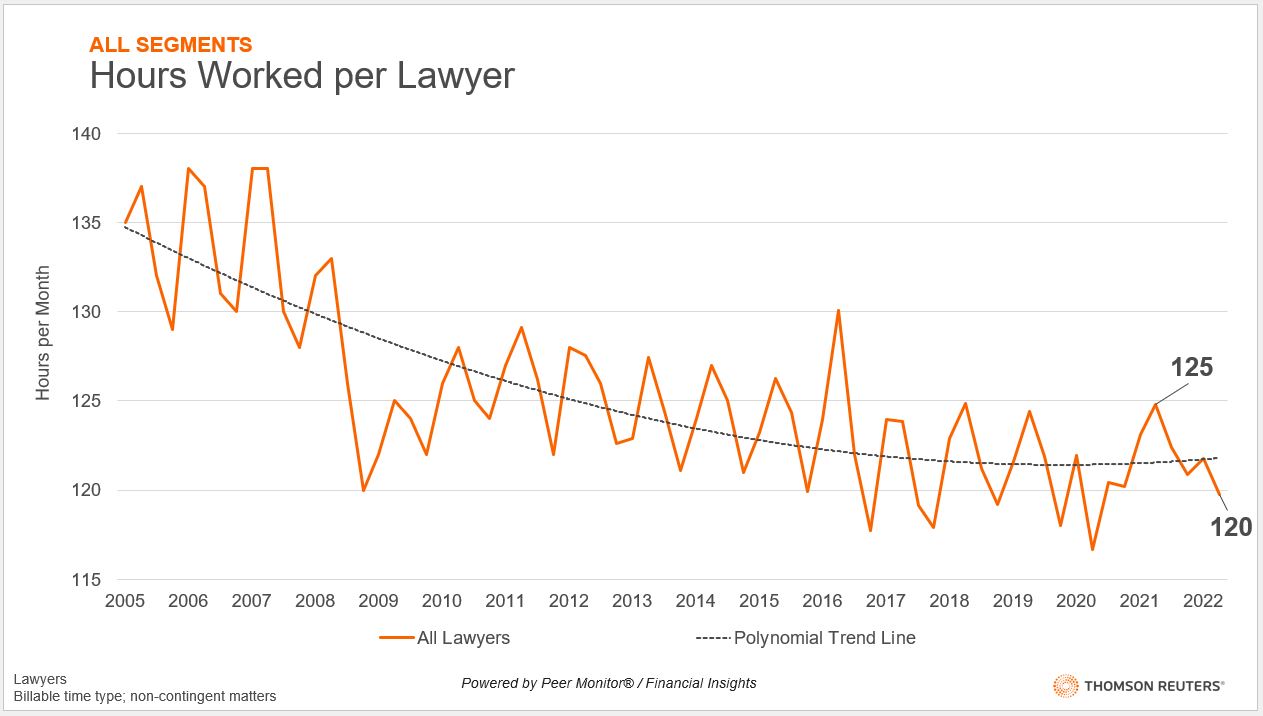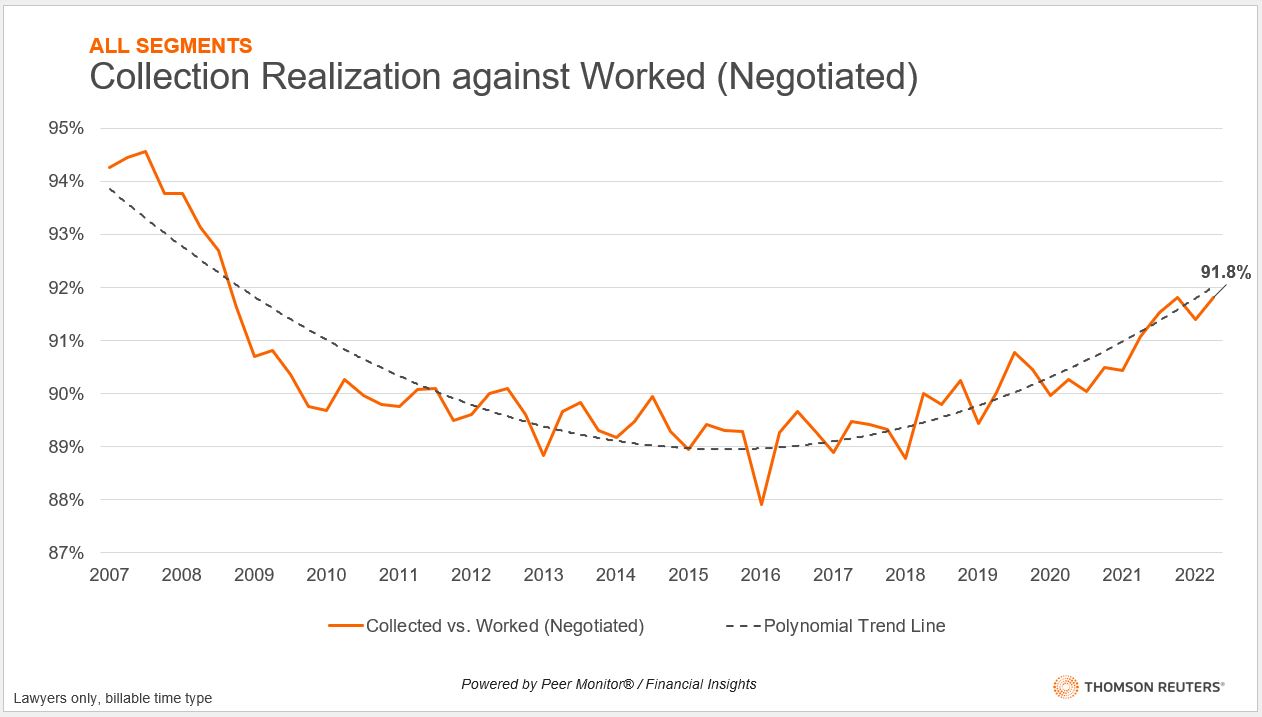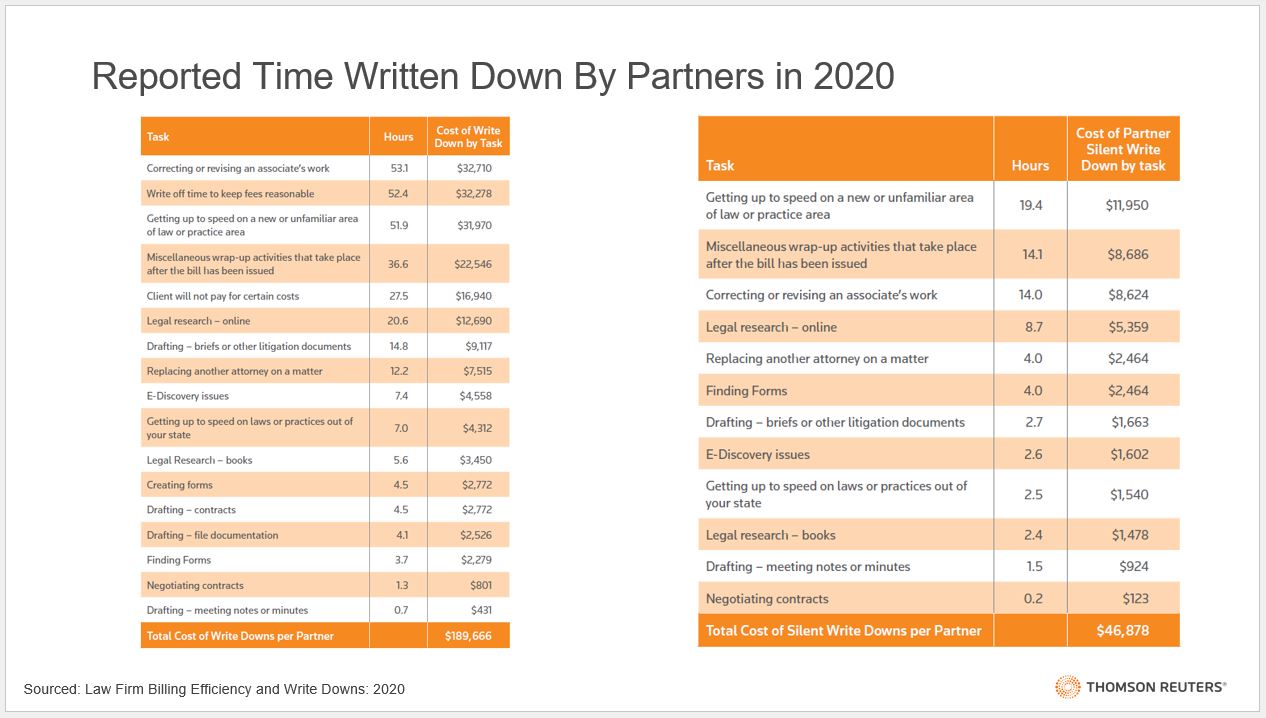One year removed from its highest score of all time, Law Firm Financial Index dropped to its lowest in history this quarter. One of the drivers of this decline in the last year: productivity
The Q2 2022 Law Firm Financial Index (LFFI) was many things, but overtly positive was not one of them. While there were bright spots, these were overshadowed by concerning decreases in demand and dramatic increases in expenses. Productivity, another of the five factors which go into calculating the Index, was likewise glum, but it received relatively little discussion in the Index report.
Now, it’s high time we talk about productivity and what may happen if firms find themselves unable to increase it.
In the second quarter, productivity experienced its largest year-over-year drop since Q1 2013 (ignoring, if you will, Q2 2020 in the heart of the pandemic lockdowns). Such a jarring drop, caused by firms growing headcount at a historically steep pace amid lower legal demand, is concerning. As the same time, Q2 2021 was dominated by concerns of burnout, where blazing hot transactional practices overworked firms’ lawyers, a workforce that was left understaffed because an entire class of associates had been delayed due to the pandemic. By this narrative, we’re measuring a drop from a period that was unsustainably busy.
Yet, when we look at the average monthly hours per lawyer historically, a different story emerges, where productivity is conspicuously low. The average lawyer worked 120 hours per month in Q2 2022, a 5 hour per month drop from Q2 2021. This is not necessarily the nadir of productivity on an hourly basis, as productivity has occasionally dipped below the 120-hours-per -month-per-lawyer mark before, and with increasing frequency. This is, however, the first time since the Global Financial Crisis (GFC) that productivity has dipped below the 120-hour mark outside of the fourth quarter of a year, a period typically burdened by a slow December heavy with holiday vacations.
Looking back even further, compared to a high of 138 hours per month before the GFC, we see long-term deterioration in productivity, especially if every lost hour constitutes hundreds of dollars in revenue per lawyer.
 Where these seemingly contradictory narratives of lawyers both being under-and-overworked combine is that both the lawyer and the hours they work are very different now than they were before the GFC. Younger associates increasingly value the life aspect of the work-life balance, and as a result are less willing to work the intense hours that firms had pushed on a previous generation.
Where these seemingly contradictory narratives of lawyers both being under-and-overworked combine is that both the lawyer and the hours they work are very different now than they were before the GFC. Younger associates increasingly value the life aspect of the work-life balance, and as a result are less willing to work the intense hours that firms had pushed on a previous generation.
Further, automation and technology have put more work into each hour. Whereas an associate 20 years ago may have spent an hour or two in a law library, the modern associate can find the same information with a few clicks before moving onto the next task. This makes the associates far more productive in terms of creating value, but continually running at this higher level also elicits a greater mental tax.
This brings us to the core concern. If law firms can’t increase the hours per month of their lawyers and the rising price of new lawyers makes continued on-boarding unpalatable, how are firms to increase revenue? In a world where 94% of firms use hourly fees as their primary billing practice, the most obvious option is increasing rates, which firms have managed to do by growing worked rates at 4.7% in Q2 compared to last year. Yet while rate growth has been solid, it’s an open question how long clients will accept such rate increases.
In a high inflation environment where customers are already predisposed to push back on price increases, firms may already need to focus on achieving higher-than-average rate growth simply to keep up with inflation in the firms’ own expenses. As such, let’s assume that firms cannot rely solely on rate increase. If then, firms can’t increase hours nor rely on rate increases, what are they to do to increase revenue?
The realization answer
 The average partner writes down roughly $237,000 in fees every year, including tens of thousands of dollars of unreported time spent correcting associates’ work and other activities, according to Thomson Reuters research. Further, despite firms making considerable gains over the second half of the 2010s in terms of realization, the average firm only collects 91.8% of the value from the hours which they work, with the majority of that loss the result of work written off before clients even receive an invoice.
The average partner writes down roughly $237,000 in fees every year, including tens of thousands of dollars of unreported time spent correcting associates’ work and other activities, according to Thomson Reuters research. Further, despite firms making considerable gains over the second half of the 2010s in terms of realization, the average firm only collects 91.8% of the value from the hours which they work, with the majority of that loss the result of work written off before clients even receive an invoice.
 Thomson Reuters Financial Insights data in 2021 showed that the average lawyer billed $58,098 less fees than they worked and collected a further $19,224 less than they billed, for a total loss of $77,322.
Thomson Reuters Financial Insights data in 2021 showed that the average lawyer billed $58,098 less fees than they worked and collected a further $19,224 less than they billed, for a total loss of $77,322.
While not necessarily “free money,” this is relatively low-hanging fruit, and is certainly enough to ride out an economic rough patch. To help determine what firms need to do to improve their realization, we talked to Paul V. Saunders, CIO and Partner at Canada’s Stewart McKelvey, a law firm leader whose firm had already enacted a successful program that increased realization substantially within five years.
We won’t divulge the entire conversation with Saunders here but there are a few key takeaways which are relevant to our discussion. First, programs such as this can be successful, with firms being able to increase realization over the long term without needing to enter into growing conflicts with clients. Innovations such as faster billing, educating partners on the way realization impacts the firms’ finances, and incentivizing good practices with added compensation are within the reach of all law firms.
Second, small improvements in realization can have radical impacts on a firm’s finances. Because it is recovering revenue on work already completed, increased realization can quickly accumulate tens of thousands of dollars per lawyer in additional profit for the firm, compared to the mild technological and time investment to recapture it.
Finally, this is not a quick transition but neither is it a taxing one. The project at Stewart McKelvey started in 2017 with the process stretching into 2022. Discussions with partners, improved education, technology rollouts, and continued management oversight were all necessary to make a substantial change in the way the firm realized revenue.
In the face of large law becoming more commoditized, firms will need to seek ways to increase the value of the hour if they want to continue using rate increases as a driver of profit growth. The same technological and efficiency measures that firms have to use to increase the value of their work to clients can also work to capture this lost revenue and thus, make up for a possibly permanent decline in productivity. Firms need only to take the time and effort to do so.
You can view the full discussion with Paul Saunders of Stewart McKelvey here.







